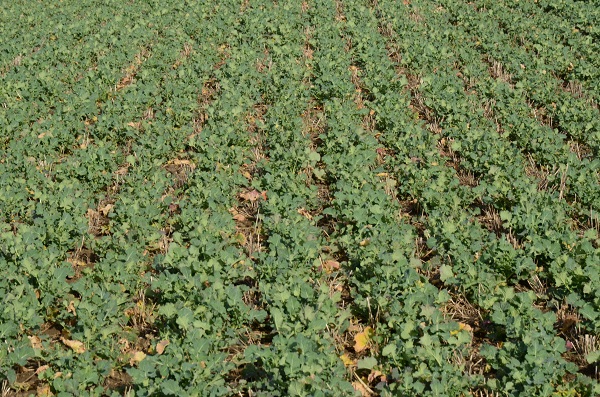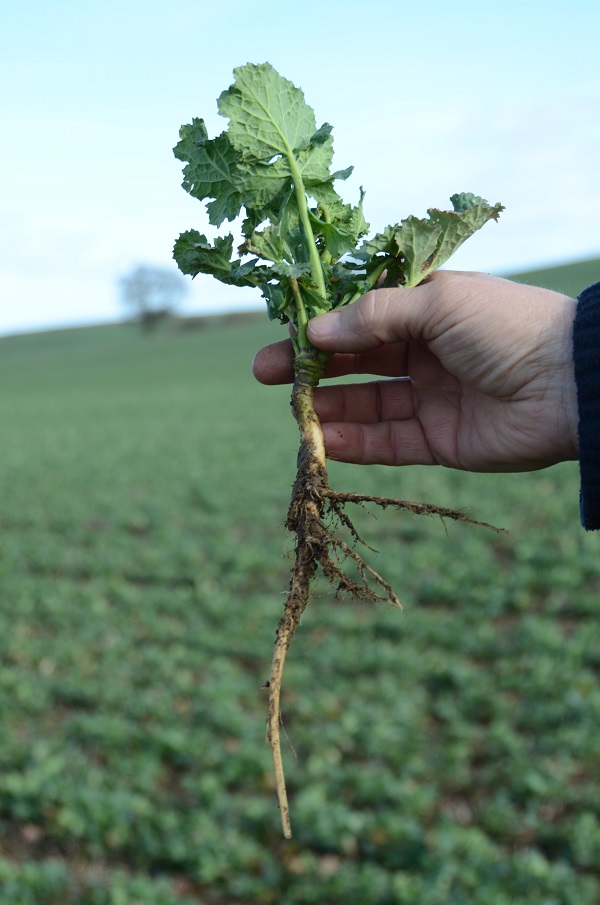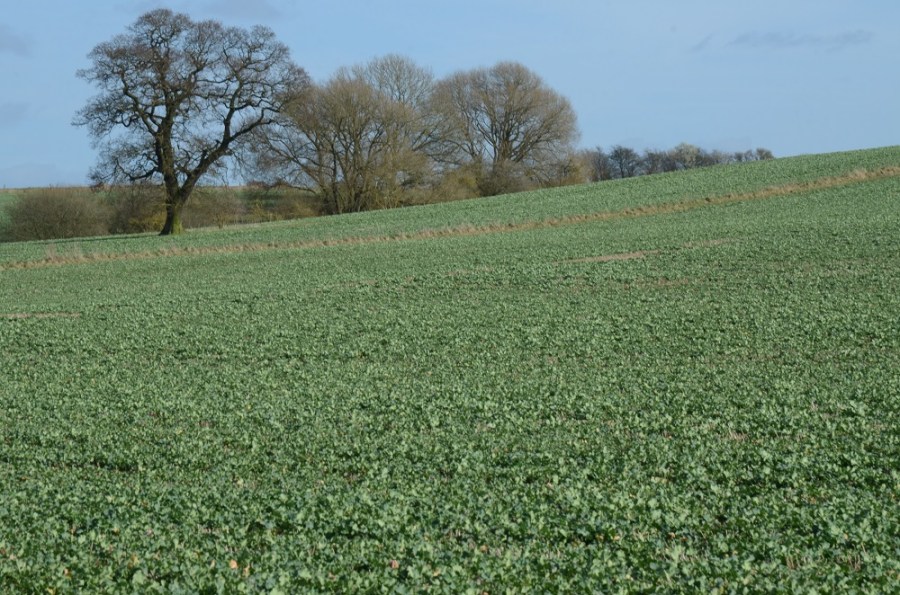Clearfield OSR varieties have increased their market share dramatically this season to about 5%. CPM investigates why two growers have adopted the system on their farms.
OSR has been a feast or famine crop on this farm.
By Rob Jones
The challenges of establishment, weed control and a low market price have prompted some growers to question the future role of oilseed rape under the three-crop rule, despite believing in the crop’s long-term future.
With very few break crop options, many producers have been facing a difficult decision – ditch the crop altogether, continue to grow OSR as they’ve always done and run the risk of poor results or use new approaches, such as the Clearfield system.
Like many others, Sean Godwin, farm operations manager for KJ Cherry and Sons at Twyford near Banbury, Oxon,was in that very position and having talked it over with his agronomist, Greg Taylor of Agrii, the conclusion was that the Clearfield system might just be the way forward.

Both growers found good establishment of Clearfield varieties a factor in their decision to adopt the system.
After trialing the system in 2015/16 he found Clearfield did everything he was looking for, so this season the farm’s entire OSR acreage is the Clearfield variety, DSV Veritas CL.
“OSR has been a feast or famine crop on this farm,” Sean explains. “If things go well, then the crop can be very good, but in a difficult season such as 2011/12, where we struggled with establishment because extremely wet weather delayed drilling, we ended up with below average yields for the farm of 3.5 t/ha.
“In 2013/14, our first season of direct drilling, we averaged 4.2t/ha and the aim this season is for over 5t/ha,” he adds.
One of the challenges faced when conventional OSR was grown on the farm was controlling charlock, poppy and cranesbill, which were becoming much more problematic, he says.
“We’d tried various chemical options and even though we used a robust pre-em programme, the results weren’t as good as we’d have liked. The medium brash soils on this farm have the potential to grow 5t/ha of OSR and we realised this in 2015, when we won the Banbury Agricultural Cup for OSR with a 5.4t/ha crop. We know that was an accurate figure because everything is measured using the weighbridge on the farm,” he comments.
Because of the way the rotation worked out for 2015/16, OSR was grown in fields that were particularly bad for charlock, explains Sean Godwin.

A Clearfield plant (Veritas CL) on 1 Mar, showing strong root development.
“We had to do something. We’d been told about a potential new chemical that might have helped to control charlock, poppy and cranesbill, but that didn’t become available commercially, so it looked as if we would be back to the drawing board.
“When I heard about the Clearfield system I was keen to try it, visited various trials and liked the look of a couple of varieties, one of which was DSV Veritas CL.
“Choosing a Clearfield variety is difficult because currently there’s no separate classification for this type in the AHDB’s OSR data, but Veritas has a good profile and was recommended by our seed supplier, United Oilseeds.”
According to Mike Mann of DSV, Veritas is a high yielding imidazolinone-resistant hybrid variety with strong youth development before winter.
“Veritas carries the RLM 7 gene giving it a multigene resistance to phoma, as well as having a strong score for light leaf spot (LLS). It’s robust and healthy, with very good drought tolerance,” he continues.
“Trials data show that this medium-tall variety has a yield potential of 102%, it scores highly for oil content, autumn vigour and winter hardiness, with a 7 for resistance to lodging, stem stiffness and LLS.
“New hybrid breeding techniques allow greater genetic diversity to be introduced, leading to new varieties with desirable agronomic characteristics, including those which can be grown under the Clearfield system.“
According to Sean Godwin, the Clearfield system has more than exceeded his expectations.
“We operate a rotation of two wheats, spring barley then OSR. After harvesting the spring barley in 2015, the straw was baled and fields being used for Clearfield OSR were direct drilled, with 100kg/ha of DAP down the spout.
“We didn’t have to worry about drilling seed at the normal 20mm deep to allow pre-ems to be used, so we ran the coulters as shallow as possible and buried the seed with the following harrow before rolling it twice.
“Compared to what we’d been used to, it was nothing short of amazing. At harvest, other than an odd bit of cow parsley, the crop was as clean as a whistle and there was nothing in the way of weeds, even cleavers.
“We achieved 3.3t/ha from the Clearfield area, which was right up there with what others were achieving that season.”
For 2016/17 all the farm’s OSR area, 33 ha, was drilled with Veritas, using SOYL mapping and variable rate seeding.
“The seed rate ranged from 1.9kg/ha to 2.9kg/ha on our silty clay and silty loam soils, aiming for an average of 45 plants/m2. We were very pleased with the way it established and in mid-Sept, applied a tank mix of 0.7 l/ha Shogun (propaquizafop) and 0.075 l/ha of Hallmark Zeon (lambda-cyhalothrin) with the addition of 0.8 l/ha of Privi Nutrifight (activated potassium salt of long chain phosphorus) to provide nutrition and enhance immunity,” he says.
The crop quickly passed the potential pinch point for flea beetle, so in early Oct 0.9 l/ha Cleravo (imazamox+ quinmerac) and wetting agent, Dash, was applied.
“That was followed in Nov by 2.8 l/ha of Crawler (carbetamide) with the aim of grassweed control, particularly blackgrass. As a separate operation, we also applied an autumn fungicide treatment for Phoma and LLS of 0.26 l/ha Savannah (tebuconazole), with 1.1 l/ha of Opti B trace elements and Nortrace Phyte P Plus at 1.1 l/ha,” he explains.
The final piece of the herbicide puzzle, 1.7 l/ha Careca (propyzamide), was applied in early Dec using the farm’s 21m Berthoud sprayer.
“We base our fertiliser applications on SOYL recommendations and the crop’s GAI, aiming for a yield of 3.5 t/ha. The first fertiliser application was at the start of March and a second later in the month. The third will be an application of stabilized urea at yellow-bud,” he says.
The use of the Clearfield system has also proved highly cost-effective, reckons Sean Godwin.
“The seed for Clearfield varieties is slightly more expensive, but we save on pre-emergence products and not using them gives us the option of baling the straw,” he comments.
Now that Clearfield varieties are capable of producing yields equal to non-Clearfield varieties, there’s no reason not to grow them, believes Ruth Stanley, farmer and campaign manager for cereal herbicides and PGRs for BASF.
An early adopter of the Clearfield System on her own farm in the Vale of Belvoir, Leics, she grows 680ha of combinable crops.
Having seen how well Clearfield varieties performed in trials, Ruth grew 11ha in the first year on her farm, 57ha the following season and currently has 75ha in the ground this year.
“The Clearfield System provided a fantastic solution to the charlock problem we have on the farm, which was starting to interfere with the rotation. The profitability of growing OSR on some of our land was becoming questionable,” she says.
“In our first year, using Clearfield was all about overcoming the charlock problem. Now we understand more about the early vigour of Clearfield varieties, that’s a benefit to us too.”
The farm’s heavy land can be a bit prone to slugs, so anything which allows the crop to get away quickly is an advantage, Ruth Stanley explains.
“When we get the timing right, we now achieve complete control of charlock, along with other broadleaf weeds. That provides the confidence to invest in a herbicide once the crop is out of the ground.”
Apart from the herbicide application, the crop is treated in the same way as a standard OSR crop, so it’s easy to manage and market, she says.
In the past couple of years, Ruth Stanley’s grown varieties from all three breeders of Clearfield seed.
“We just grew a 6ha trial area of Veritas last year as it was a new variety. It was very vigorous and was out of the ground quickly compared with the other OSR varieties we’d drilled and it looked well all year.
“You can never really tell with OSR, but we had high hopes for it. Veritas was the highest yielding OSR variety on the farm last year and outperformed the average of our standard varieties by 0.3t/ha.”
This year, the area of Veritas has been increased to almost 50ha on Ruth Stanley’s farm.
“It looks good now that the ground is starting to warm up and is starting it’s spring growth spurt. My advice to farmers who are thinking of trying the Clearfield System is ‘give it a go’. We did and haven’t looked back.
“You need to understand your weed burden and get the herbicide timing right to match the target, but that’s the same with any herbicide application,” she says.




